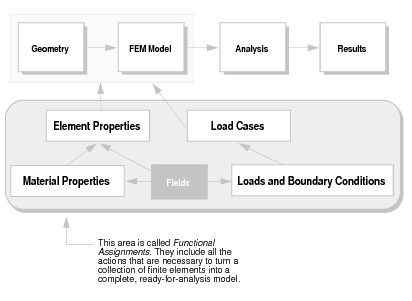XXXXXXXXXXXXXXXXXXXXXXXXXXXXXXXXXXXXXXXXXXXXXXXXXXXXXXXXXXXXXXXXXXXXXXXXXXXXXXXXXXXXXXXXXXXXXXXXXXXXXXXXXXXXXXXXXXXXXXXXXXXXXXXXXXXXXXXXXXXXXXXXXXXXXXXX''"> 1.1 Orientation
Functional Assignments are necessary to turn a collection of finite elements into a complete finite element model. The five Functional Assignment Applications assign element properties, material properties, loads and boundary conditions, load cases, as well as assign those features as a function of a mathematical field.
The diagram below describes the basic flow of finite element analysis and its relationship to the application of Functional Assignments. The five Functional Assignment Application tasks are the topic of this chapter.

Each of the five Functional Assignments are accessed by a menu selection in the main form. Each Functional Assignment area deals with groups of items, typically called sets, that have names and may be of different types.
A Field is a special kind of Functional Assignment. Fields define spatial and time- or temperature-dependent distributions of scalar or vector quantities. These functions can be defined by tables or general PCL expressions in real or parametric space. They are extremely useful tools in defining complex distributions of element properties, material properties, loads or boundary conditions. Examples include: the temperature or stress dependence of a material property, the thickness distribution of a shell, and a time-dependent pressure pulse.
An important feature of Patran is the ability to apply element properties and LBCs to the geometry prior to meshing. This eliminates the need to reapply them if the finite element model is remeshed.
The primary Functional Assignment actions are Create, Delete, Modify, and Show. These actions refer both to the contents of the sets themselves, and to their associativity to the geometric and FEM entities that make up the model.
Create | Used to create the element property sets, material property sets, loads and boundary conditions sets, load cases, and the various fields used to define these sets. |
Delete | Used to remove the Functional Assignment sets. |
Modify | Used to edit the Functional Assignments sets. |
Show | Provides the capability of displaying information in both tabular and plot format. The most common plot type is contour plot of the selected data on the model, although in fields and materials XY plotting of data is also supported. Displays other than contours are also available such as Marker displays, where annotated symbols that indicate a material type or load direction are shown. |
An important characteristic of the Patran approach to finite element analysis is the ability to retain information in the database. Thus, the model database includes not only the current analysis but also elements of all previous analyses: different loads, materials, configurations, etc. This archival ability adds an important new dimension to analysis: a record of its history.
Many of the actions that are taken in Functional Assignments are analysis code specific. The types of element properties that can be created, the property input forms, and the types of loads that can be applied all depend on the code preference selected. It is important that this selection be made before working in the Functional Assignments areas.
A database inherently assumes that a single code and analysis type are being used. If the analysis code preference is changed, Patran will attempt to convert all code specific information to the new preference. Switching the analysis code preferences back and forth will, in general, not result in a complete translation. To use an existing database with an alternate analysis code, it is recommended that the database be duplicated.

